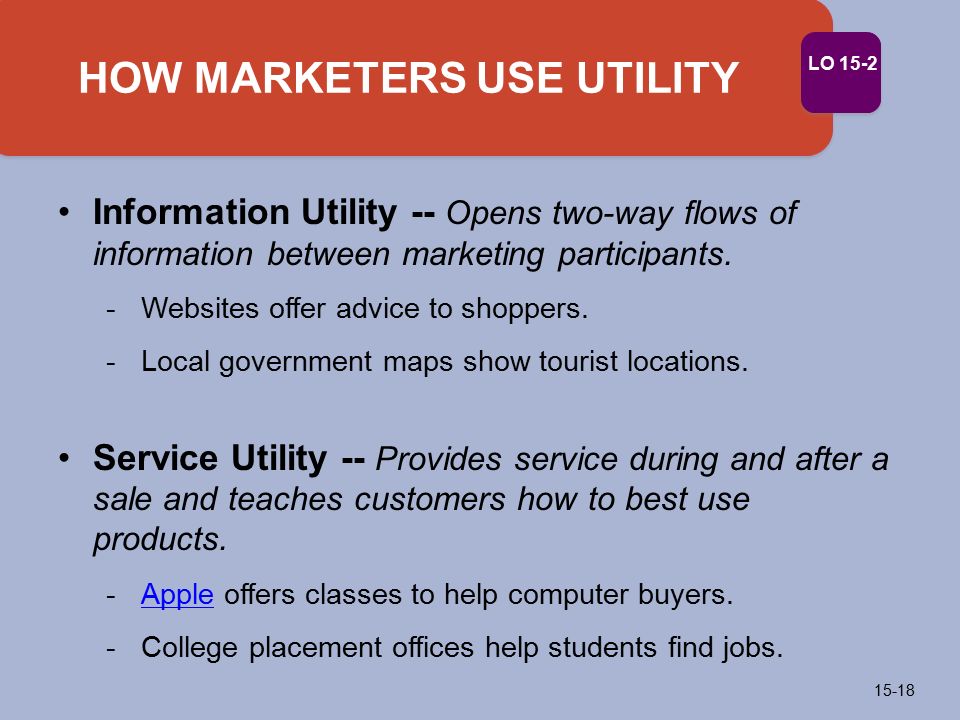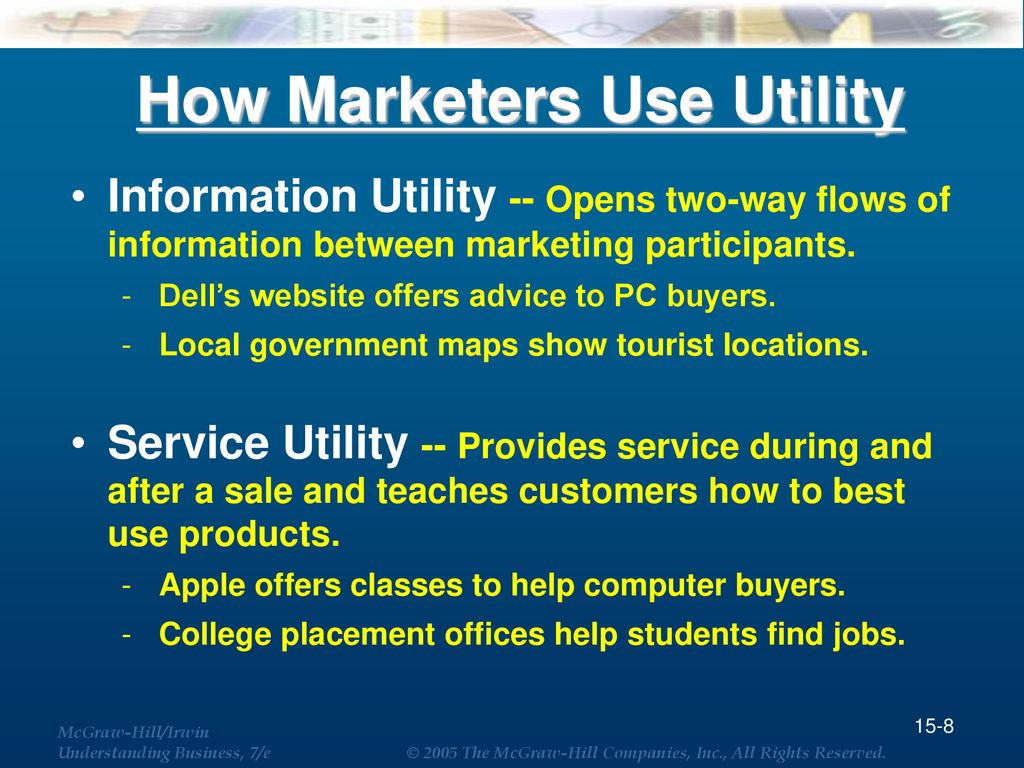A two-way flow of information between marketing participants is opened by interactive utility. Interactive utility enables communication and interaction among marketing participants.
Interactive utility plays a crucial role in facilitating communication and information exchange between marketers and consumers. It allows for real-time feedback and engagement, creating a dynamic relationship between the two parties. By opening a two-way flow of information, interactive utility enhances marketing effectiveness, enables personalized communication, and provides valuable insights for marketers.
This type of utility empowers consumers to actively participate in shaping marketing strategies and offerings. It fosters transparency and trust, leading to improved customer satisfaction and loyalty. Overall, interactive utility serves as a powerful tool for building meaningful connections and fostering collaboration between marketers and consumers.

Credit: slideplayer.com
The Role Of Two-way Utility
The Role of Two-Way Utility in marketing plays a crucial role in opening up channels of communication and fostering collaboration between participants. By ensuring that information flows in both directions, it enhances the efficiency of marketing efforts and strengthens relationships with customers and partners.
Enhancing Communication Channels
Two-way utility facilitates the exchange of ideas, feedback, and insights between marketers and their target audience. It allows for real-time interaction, enabling marketers to gather valuable input and respond promptly. This direct line of communication empowers businesses to tailor their strategies to meet the specific needs and preferences of their audience, resulting in more effective marketing campaigns.
Fostering Collaboration
Two-way utility also promotes collaboration among different stakeholders within the marketing ecosystem. It encourages sharing of resources, expertise, and best practices, leading to a more cohesive and coordinated approach to marketing initiatives. By breaking down silos and encouraging open dialogue, it enables the pooling of talents and resources for mutual benefit.

Credit: slideplayer.com
Benefits Of Two-way Information Flows
In marketing, the utility enabling reciprocal information exchange is known for enhancing engagement and brand loyalty. This two-way flow benefits both marketers and customers, fostering stronger relationships and personalized interactions for mutual growth and success.
Benefits of Two-Way Information Flows Improving Customer Understanding In today’s fast-paced and interconnected world, effective marketing requires a deep understanding of customers. One way to gain this understanding is through two-way information flows, which allow for a seamless exchange of insights between marketing participants. By facilitating communication and feedback, this type of utility opens up a world of possibilities in terms of customer understanding. By encouraging customers to provide feedback, companies gain invaluable insights into their preferences, needs, and pain points. This understanding allows marketers to develop highly targeted and personalized campaigns that resonate with customers and drive engagement. Additionally, by actively listening to customers, companies can identify trends and market shifts, enabling them to adapt their marketing strategies accordingly. Increasing Marketing Effectiveness Two-way information flows also significantly increase marketing effectiveness. When marketers have access to real-time feedback from customers, they can quickly identify what works and what doesn’t. This allows them to make data-driven decisions and optimize their campaigns for maximum impact. Furthermore, two-way information flows foster a sense of collaboration and co-creation with customers. By involving customers in the marketing process, companies can build stronger relationships and brand loyalty. This involvement not only makes customers feel valued but also allows marketers to tap into their collective wisdom and creativity, leading to more innovative and effective marketing initiatives. In conclusion, the benefits of two-way information flows are numerous. From improving customer understanding to increasing marketing effectiveness, this type of utility plays a vital role in modern marketing strategies. By leveraging technology and fostering communication, companies can create a dynamic and interactive relationship with their customers, ultimately driving business growth and success.Challenges And Solutions
To foster two-way information flows between marketing participants, the integration of interactive utility provides a dynamic solution. This utility type facilitates engagement, feedback, and real-time dialogue, overcoming challenges associated with one-directional communication channels.
Overcoming Communication Barriers
Implementing Feedback Mechanisms
Technology’s Impact
Technology has transformed the way marketing participants interact and share information. It has opened up new avenues for two-way flows of data, revolutionizing how businesses engage with their audience. Let’s explore the impact of technology on empowering real-time interactions and enabling data-driven insights in marketing.
Empowering Real-time Interactions
Real-time interactions are critical in today’s fast-paced marketing landscape. Technologies such as chatbots and instant messaging platforms have empowered businesses to engage with customers in real time. This fosters immediate feedback, enhanced customer support, and personalized interactions.
In addition, live streaming and video conferencing technologies allow marketers to connect with their audience in real time, enabling interactive product demos, live events, and real-time Q&A sessions.
Enabling Data-driven Insights
Technology has enabled the collection and analysis of vast amounts of data, providing marketers with valuable insights. Big data analytics and machine learning algorithms help businesses derive actionable insights from customer behaviors, preferences, and trends.
Moreover, customer relationship management (CRM) software and marketing automation platforms utilize data-driven insights to segment audiences, personalize marketing campaigns, and measure campaign performance.
Maximizing Marketing Engagement
In today’s competitive marketing landscape, it’s crucial for businesses to create two-way flows of information between their marketing participants. This type of utility opens up endless possibilities for engagement, enabling companies to connect with their target audience on a deeper level. Maximizing marketing engagement is all about creating personalized strategies and effectively measuring engagement metrics.
Personalized Engagement Strategies
Personalization is the key to capturing the attention of your audience. By tailoring your marketing efforts to meet the unique needs and preferences of individual customers, you can establish a meaningful connection that sets your brand apart from the competition. Here are some strategies to enhance personalized engagement:
- Create customer personas: Identify common characteristics and interests among your target audience to create accurate and effective personas.
- Segment your audience: Divide your customer base into segments based on demographics, behaviors, or preferences. This allows you to deliver tailored messages and offers to each group.
- Utilize dynamic content: Implement dynamic content on your website and marketing materials to deliver personalized experiences to visitors. This involves showcasing content based on the user’s previous interactions or preferences.
- Offer personalized recommendations: Leverage data analytics and algorithms to offer personalized recommendations to customers, increasing their engagement and satisfaction.
Measuring Engagement Metrics
Measuring engagement metrics is essential for understanding the effectiveness of your marketing initiatives and making data-driven decisions. By tracking these metrics, you can gain valuable insights into your audience’s behavior and make adjustments accordingly. Here are some crucial engagement metrics to monitor:
- Click-through rate (CTR): This measures the percentage of people who click on a specific link or call-to-action within your marketing communications.
- Conversion rate: The conversion rate tracks the number of website visitors who take a desired action, such as making a purchase or filling out a form.
- Time on page: This metric indicates how long a visitor stays on your website or a specific page, providing insights into their level of engagement.
- Social media engagement: Monitor the number of likes, comments, and shares on your social media posts to gauge the effectiveness of your content.
By regularly analyzing these metrics, you can gain a comprehensive understanding of how effectively your marketing campaigns are engaging your audience. Utilize the insights to refine your strategies and ensure continuous improvement.

Credit: slideplayer.com
Future Trends
In the ever-evolving landscape of marketing utilities, staying abreast of future trends is crucial for successful two-way flows of information between marketing participants. Emerging technologies and strategies are shaping the way marketing is conducted, allowing for more efficient and effective communication among stakeholders.
A1-powered Communication Tools
AI-powered communication tools are revolutionizing the way marketers interact with their target audience. Chatbots and virtual assistants powered by AI are enabling real-time, personalized communication, enhancing customer experiences, and driving conversion rates.
Predictive Analytics In Marketing
Leveraging predictive analytics in marketing is becoming increasingly prevalent. By harnessing the power of big data and machine learning algorithms, marketers can anticipate consumer behavior, personalize marketing strategies, and make data-driven decisions with greater accuracy and precision.
Frequently Asked Questions
What Is The Two-way Flow Of Communication Between Marketing Participants Called?
The two-way flow of communication between marketing participants is called interactive marketing. It allows for real-time interaction and feedback.
What Are The Types Of Utility Commonly Provided By Marketing Intermediaries?
Marketing intermediaries commonly provide time, place, form, and possession utilities to bridge the gap between producers and consumers. Time utility involves making products available at the right time, while place utility ensures availability at convenient locations. Form utility pertains to converting raw materials into finished products, and possession utility relates to facilitating the ownership transfer of products.
Which Marketing Function Provides Place Utility Or Distribution From The Producer To The Consumer?
The marketing function that provides place utility or distribution from the producer to the consumer is known as “distribution or channel management. ” This function ensures that products reach consumers efficiently and effectively.
Which Form Of Utility Is Added By Marketing Intermediaries Who Make Products Available When They Are Needed?
Marketing intermediaries add time utility by making products available when needed by consumers.
What Is The Role Of A Marketing Utility?
A marketing utility facilitates the exchange of products or services between businesses and consumers.
Conclusion
To foster efficient communication between marketing participants, the two-way flow of information is crucial. By enabling both parties to exchange feedback, ideas, and updates, this type of utility enhances collaboration and understanding. With open lines of communication, businesses can adapt their strategies, personalize their marketing efforts, and ultimately build stronger relationships with their customers.
Embracing this interactive approach can lead to greater success and competitiveness in the ever-evolving marketplace.











